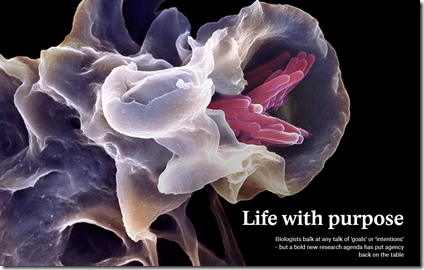
It may seem strange to describe even the smallest cell having a goal and a purpose but the evidence demonstrates that all life has such an orientation.
When a life force or organism has such energy and direction, we call this ‘agency’. As Phillip Ball states: ‘A bottom-up theory of agency could help us interpret what we see in life, from cells to societies – as well as in some of our ‘smart’ machines and technologies.’
I would recommend the work and books of Phillip Ball to anyone in safety. I have read his works on Critical Mass, Curiosity and Invisible, The Dangerous Allure of the Unseen.
Whilst I don’t share the same worldview as Phillip Ball, I find his work helpful in understanding a truly scientific understanding of the world. He is certainly not interested in the dogma of scientism and acknowledges much of what we don’t know even the importance of sustaining a sense of mystery.
Agency can be both a metaphor, an anthropomorphic personification and an attribute. It denotes something that has an energy and will of itself. Even a single celled bacteria acts according to a direction and purpose, despite having no brain.
One of the impediments to understanding agency has been the doctrine of behaviourism. Behaviourism asserts that all biology behaves as it does because of ‘learning’ (conditioning). (BTW, conditioning and training are not learning). There is no evidence for such an assertion.
And we know through our own experience, all biological life adapts and makes choices to preserve itself. The ecological system moves and changes according to homeostatic energy to preserve and sustain itself.
Some of the excellent research by Mark Johnson is also worth reading on the matter of homeostasis, particularly in relation to embodied learning and risk. These are:
- Embodied Mind, Meaning, and Reason, How our Bodies Give Rise to Understanding
- Morality for Humans Ethical Understanding from the Perspective of Cognitive Science
- The Body in the Mind, The Bodily Basis of Meaning, Imagination, and Reason
- The Meaning of the Body, Aesthetics of Human Understanding
Of course, these are not the kinds of books read in risk and safety yet are essential reading to understanding the nature of human judgment and decision making and the challenges of risk.
Unless Safety tackles the tough questions of agency, decision making, judgment and purpose, it will never understand the nature of motivation or perception in the face of risk.
One thing is for sure, focusing on the outcome (safety and injury rates) disables any sense of understanding the process of homeostasis and risk.
Understanding homeostasis is essential to understanding the nature of by-products and trade-offs.
One would think that the very foundation of the safety industry might be seeking an understanding of why people do what they do. Apparently not.
All of this research demonstrates clearly that the Bradley Curve is nonsense put forward by DuPont. It shows just how religious DuPont is when it demands that we ‘Believe the Impossible’. This from the same company that brags about safety with a history of corruption and unethical behaviour (https://safetyrisk.net/dark-waters-the-true-story-of-dupont-and-zero/). And yet still Safety buys the cool aid!
The construction of the Bradley Curve was made up for the sole purpose of selling zero to a gullible industry that wants to believe the impossible. The Bradley Curve and zero are a fairy tale.
Humans and all biological life do NOT have a ‘natural instinct for harm (https://safetyrisk.net/safety-curves-and-pyramids/).
Like many things put forward in the safety code (https://safetyrisk.net/deciphering-safety-code/ ), it is the opposite. All biological life is driven by the energy for homeostasis. The Ecology remembers and ‘learns’ because it embodies its experiences and reacts to changes that affirm or threaten it. Unless one understands learning as embodied, they are not speaking about learning, they are talking about training and cognitive change.
When we think of Ecology we must also reflect on the way Culture works. Culture has its own energy and agency for regulation, sustainability and purpose. Cultures have their own agency – homeostasis. This is why things Safety does often backfire, because it defines culture through the lens of engineering and behaviourism. It then comes up with the brilliant idea that the best way to tackle culture is to not talk about it.



Do you have any thoughts? Please share them below